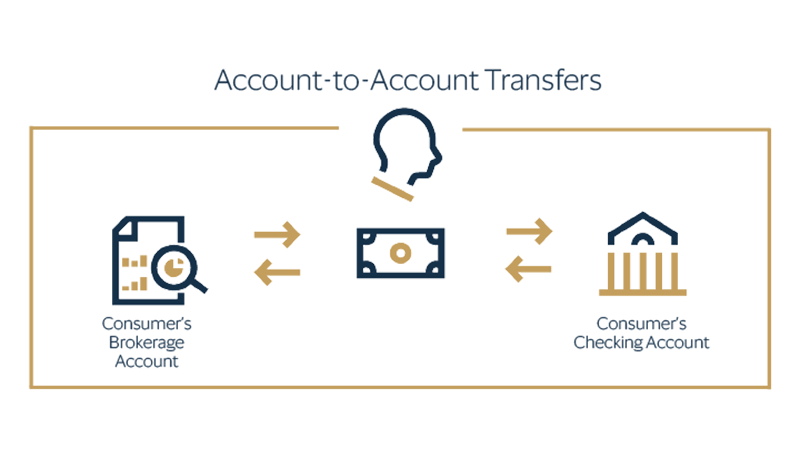

Customers transferring funds between their own accounts at the same or different institutions can face risky delays through slow ACH or bank wire rails. Yanilsa Gonzalez-Ore, North America Head of Visa Direct, explains why this space is ripe for disruption.
In today’s world of payments, speed matters. Consumers are increasingly expecting “faster everything”, a demand driven by the proliferation of peer-to-peer (P2P) payments enabling individuals to quickly send money to a friend or pay for products and services. The access, speed and convenience of real-time¹ payments are becoming the norm and that means greater opportunity for financial institutions to differentiate the money movement experiences they deliver to their customers. One area slower to initiate real-time speed is in traditional account-to-account (A2A) transfers.
A2A transfers happen when a customer transfers funds between their own accounts (brokerage, crypto, savings, and checking) held at different financial institutions, such as a savings or brokerage account to a separate checking account. Too often, consumers must rely on outdated processes such as traditional Automated Clearing House (ACH) methods that can take days to complete, ultimately impacting time-sensitive investment opportunities and on-time bill payments.

“Today, consumers are accustomed to being able to quickly send money to friends and family using various P2P payment platforms. But moving money between your own accounts is still a lengthy and inefficient process,” says Yanilsa Gonzalez-Ore, SVP, North America Head of Visa Direct.
Surveyed U.S. consumers own, on average, 8 financial accounts and conduct 15 transactions between them per year, accounting for $3 trillion in annual money movement via A2A transfers.² This can result in the need to optimize finances and investments across those accounts – and consumers want and expect to do it with ease anytime, anywhere.
A survey by Visa and Aite Group found that 90 percent of surveyed U.S. consumers want the flexibility of real-time transfers between their financial accounts.² And 70 percent of surveyed U.S. consumers said they prefer card-based real-time payments for transfers.²
"Two factors that are driving customer demand today are user interface simplicity and real-time money movement,” says Gonzalez-Ore. “Disrupting the A2A space and delivering real-time payments can be a win-win for any financial institution. You may receive deposits faster, and in turn, you'll potentially see higher retention from those clients by meeting their demand. There are potential benefits for everyone in the ecosystem,” she adds.
Younger demographics are a step ahead when it comes to technology adoption and digital experiences. Quick gratification is the expectation for Millennial and Gen Z customers. This matters now because there will likely be an overall demographic shift in the U.S. propelled by a transfer of wealth across generations. “We will likely see more and more demand for faster, more seamless transfers and transactions,” says Gonzalez-Ore.
A fast way to transfer
To meet this demand, financial institutions are relying on Visa Direct to offer their customers real-time³ payments for P2P payment flows and more. Visa’s real-time³ network enables consumers, businesses, and financial institutions to send and receive money to more than 5 billion cards and accounts worldwide.
Solving the challenges of slow A2A transfers enables consumers to move funds between their accounts in real-time³ using their debit or prepaid card in the following ways:⁴
- Opportunistic Investing: Quickly move funds from an eligible card to a brokerage account to capture a rapid trade opportunity
- Emergency Payouts: Move money out of one account to another external debit account in real-time³ to pay for emergency expenses
- Cashing Out: Cash out of a fintech wallet or send money from a brokerage account to a checking account
Key differentiators: Speed and scale
These use cases represent the significant opportunities to deliver real value in A2A transactions. “By providing this service, financial institutions can differentiate themselves by leveraging the speed, convenience, and flexibility of real-time³ payments and a simple digital experience for their customers,” says Gonzalez-Ore.
Transfers made on slow ACH or bank wire rails lack real-time authorization, potentially leaving both businesses and consumers frustrated. By providing a single point of access to multiple global payment networks, Visa Direct delivers speed, reliability, and scale.
Seventy-four percent of surveyed U.S. consumers said they might consider switching to a financial institution that offers real-time transfers.² “A2A is ripe for disruption and fintechs and neobanks have a great appetite to innovate in this space,” says Gonzalez-Ore. “The old adage that time is money rings true here and the fact is, consumers should expect to transfer funds when they need. Now there is a way to meet this demand securely and efficiently to benefit the whole ecosystem.”
Innovation has made it possible to move money in real-time across a multitude of use cases and account-to-account transfers should be no different. By integrating real-time³ payment solutions, financial institutions can expand their own money movement offerings to gain a competitive edge and stay ahead of the ever-changing payments landscape.
All brand names, logos and/or trademarks are the property of their respective owners, are used for identification purposes only, and do not necessarily imply product endorsement or affiliation with Visa.
- Actual fund availability depends on receiving financial institution and region.
- Aite Group and Visa Inc. Banking and Brokerage Consumer Study (1,957 U.S. consumers), April 2019 – March 2020.
- Actual fund availability varies by receiving financial institution, receiving account type, region, and whether transaction is domestic or cross-border.
- Use cases are for illustrative purposes only. Program providers are responsible for their programs and compliance with any applicable laws and regulations.